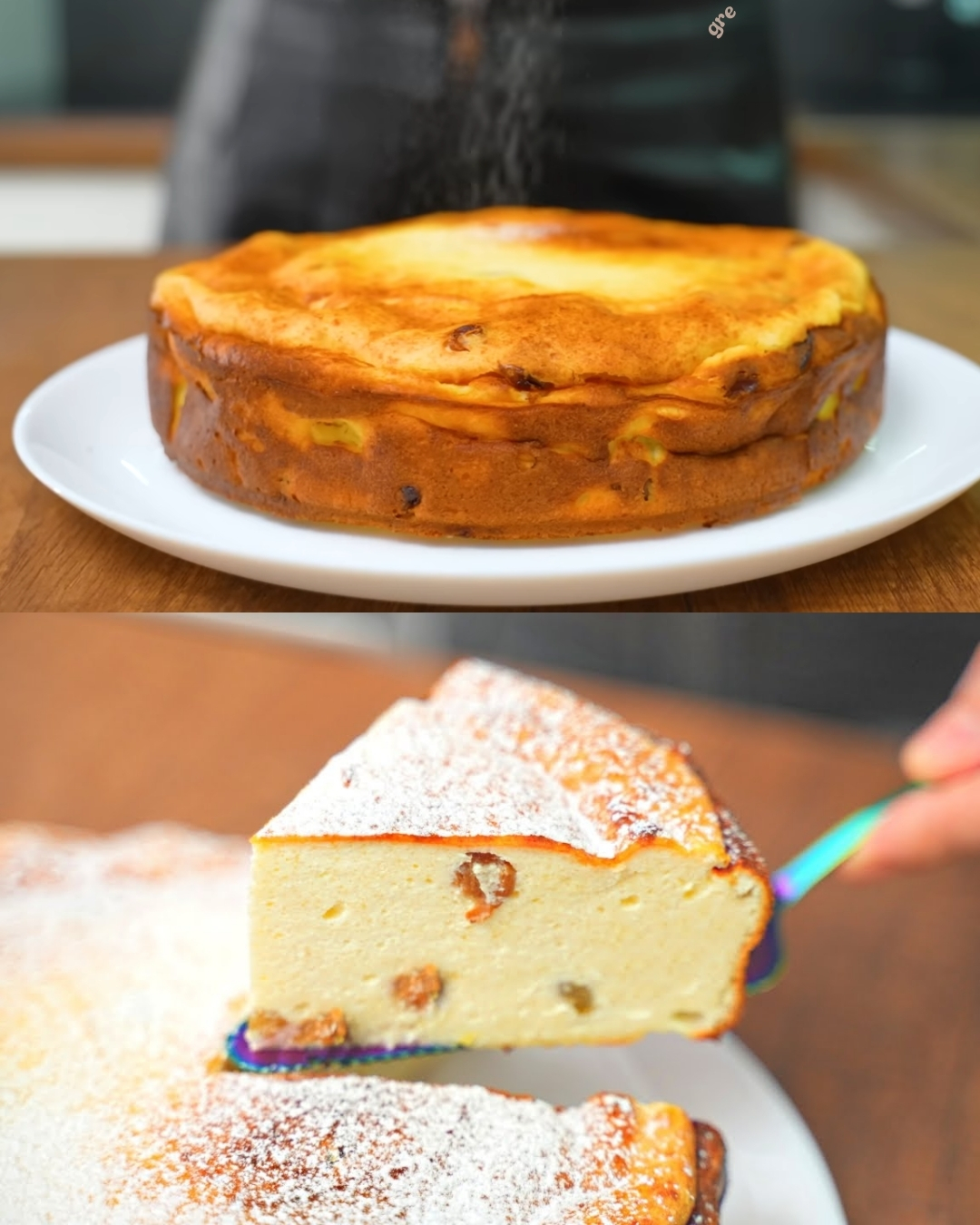Delightfully fluffy, gently sweetened, and melt-in-your-mouth tender, this Soft and Juicy Cottage Cheese Casserole is a comforting classic that’s perfect for breakfast, dessert, or even a light dinner. It’s made from simple, nourishing ingredients: cottage cheese (or curd), eggs, sour cream, semolina, and optional flavorings like lemon zest, vanilla, and raisins. Baked to a golden top and creamy center, this casserole is a favorite across many homes, especially in Eastern European cuisine.
Whether you serve it warm with jam or cold with tea, this casserole is one of those timeless dishes that feels both nostalgic and nourishing. Lightly sweet and naturally high in protein, it’s a family-friendly recipe that satisfies without being heavy.
Cooking Time
Preparation Time: 15 minutes
Cooking Time: 30–45 minutes
Cooling Time: 15 minutes
Total Time: Approx. 1 hour 15 minutes
Ingredients
-
Cottage cheese (curd)
-
Eggs
-
Sugar
-
Sour cream
-
Semolina
-
Vanilla sugar (optional)
-
Lemon zest (optional)
-
Raisins (optional)
-
Salt
-
Butter for greasing the pan
Step-by-Step Cooking Directions
-
Pour boiling water over raisins and let soak for 5–10 minutes. Drain and pat dry.
-
Separate egg yolks and whites into two bowls.
-
In a large bowl, mix cottage cheese with egg yolks, salt, sugar, sour cream, semolina, and vanilla sugar. Blend with a hand blender for 5 minutes until smooth.
-
Add lemon zest and raisins (if using), then stir to combine.
-
In a separate bowl, beat the egg whites until soft peaks form.
-
Gently fold the egg whites into the curd mixture using a spatula.
-
Grease a baking dish with butter and transfer the curd mixture into it, smoothing the top.
-
Bake in a preheated oven at 180°C (350°F) for 30–45 minutes until golden and set.
-
Allow to cool slightly before slicing and serving.
Nutritional Information (per serving)
-
Calories: 220–260 kcal
-
Protein: 12–14 g
-
Fat: 10–12 g
-
Carbohydrates: 18–20 g
-
Fiber: 1 g
-
Calcium: High
-
Sugars: Moderate (depending on amount added)
The Origins and Popularity of the Recipe
The cottage cheese casserole, or zapekanka, is a cherished traditional dish in Russian, Ukrainian, and Central European households. Originally created as a way to use leftover curd or dairy, it has evolved into a comfort food staple that bridges the gap between dessert and breakfast. Its popularity stems from its accessibility, nutritional value, and deeply satisfying texture.
Often served in kindergartens, cafeterias, and family gatherings, this dish evokes childhood memories for many. In recent years, it’s gained popularity worldwide among those seeking high-protein, low-gluten alternatives to flour-based desserts and breads.
Reasons Why You’ll Love the Recipe
-
Naturally sweet and satisfying without being overly rich
-
High in protein and calcium
-
Great for kids and adults alike
-
Perfect for meal prep – enjoy warm or cold
-
Very customizable – add fruits, spices, or chocolate
-
Uses everyday ingredients you likely have at home
Health Benefits
This casserole is a nutrient-dense dish packed with protein from eggs and cottage cheese, healthy fats from sour cream and eggs, and energy from semolina. It’s ideal for those who want a high-protein, lower-carb option that’s still comforting and indulgent. Adding raisins boosts fiber and natural sweetness, while lemon zest gives a dose of vitamin C and fresh aroma.
For a healthier version, you can reduce the sugar or substitute it with honey, maple syrup, or erythritol. You can also use low-fat cottage cheese or sour cream for a lighter dish without sacrificing flavor.
Serving Suggestions
-
With jam or honey: Strawberry, apricot, or blueberry jams complement the curd beautifully
-
Sprinkle with powdered sugar: For a classic dessert-style presentation
-
Serve with yogurt or crème fraîche: Adds tang and richness
-
Top with fresh fruits: Berries, bananas, or stewed apples add freshness
-
For breakfast: Pair with tea, coffee, or a warm cup of milk
Common Mistakes to Avoid
-
Using grainy cottage cheese without blending: Results in a lumpy texture
-
Skipping semolina or flour: The casserole may not hold together properly
-
Overbaking: Causes the casserole to become dry and crumbly
-
Folding egg whites too quickly: Can deflate the air and reduce fluffiness
-
Not letting it cool before slicing: It may fall apart when too hot
Pairing Recommendations
-
Drinks: Hot tea (black, green, or herbal), lattes, or fresh orange juice
-
Sides: Fresh fruit salad, nut butter drizzle, or a spoonful of Greek yogurt
-
Desserts: Pair with baked apples or poached pears for a cozy evening treat
Cooking Tips
-
Use fine curd or farmer’s cheese for the best creamy texture
-
Beat egg whites just until soft peaks – not too stiff
-
Add a pinch of cinnamon or nutmeg for warming spice
-
Let the casserole rest at least 10–15 minutes before serving
-
Line the bottom of the baking dish with semolina to avoid sticking
Similar Recipes to Try
-
Russian Syrniki (Cheese Pancakes)
-
German Käsekuchen (Baked Cheesecake)
-
Sweet Cottage Cheese Pie with Raisins
-
Lemon Ricotta Cake
-
Rice and Cottage Cheese Casserole
Variations to Try
-
With fruit: Add chopped apples, pears, or dried apricots
-
Chocolate version: Stir in cocoa powder or chocolate chips
-
Gluten-free: Use almond flour instead of semolina
-
Low-sugar: Sweeten with mashed banana or stevia
-
Savory twist: Omit sugar, add herbs and grated cheese
Ingredient Spotlight: Cottage Cheese (Curd)
Cottage cheese, known in Eastern Europe as tvorog or curd, is the heart of this dish. It’s rich in protein, calcium, and B vitamins. It has a mild tang and crumbly texture that blends into smooth, luscious batters when mixed with eggs and sour cream.
Look for full-fat, fine-textured cottage cheese for best results. If yours is coarse or grainy, blend it well to ensure a light and even casserole. This cheese is also an excellent base for both sweet and savory recipes, making it a versatile fridge staple.
Conclusion
This Soft and Juicy Cottage Cheese Casserole is more than just a recipe — it’s a taste of tradition and home. From its creamy interior to its golden, gently caramelized top, every bite delivers warmth and comfort. Whether you’re enjoying it with your morning coffee, serving it to your children, or treating guests to a rustic dessert, this casserole is sure to please.
Its simple ingredients, flexible flavor options, and nourishing properties make it a timeless favorite. Give it a try, and you’ll soon find it becoming part of your weekly rotation.
Frequently Asked Questions
1. Can I use ricotta instead of cottage cheese?
Yes, ricotta can be used as a substitute. Just make sure it’s well-drained and has a similar texture. It may produce a slightly smoother result.
2. Can I replace semolina with flour?
Yes. All-purpose flour or oat flour can be used in place of semolina, though semolina gives a more traditional texture.
3. Can I make this casserole without raisins?
Absolutely. Raisins are optional and can be swapped with other dried fruits or left out entirely.
4. Is it necessary to separate the eggs?
Separating the eggs and beating the whites creates a fluffier texture. If you skip this, the casserole will be denser.
5. How do I store leftovers?
Store in an airtight container in the refrigerator for up to 3 days. Reheat gently in the oven or microwave.
6. Can I freeze the casserole?
Yes, but it’s best enjoyed fresh. If freezing, cool completely, wrap tightly, and freeze for up to 1 month. Thaw in the fridge before reheating.
7. What if I don’t have a blender?
You can mash the ingredients very well with a fork or use a food processor for a smoother texture.
Advertisement
8. Can I make this sugar-free?
Yes. Use natural sweeteners like stevia, erythritol, or skip the sugar and rely on fruit for sweetness.
9. How do I know when it’s done baking?
The top will be golden, and the center should be set but still soft. A toothpick should come out mostly clean.
10. What can I serve with this casserole?
It pairs beautifully with fresh fruits, yogurt, honey, or a drizzle of fruit syrup for a breakfast or dessert-style dish.

